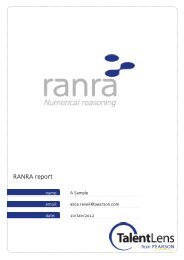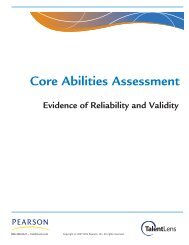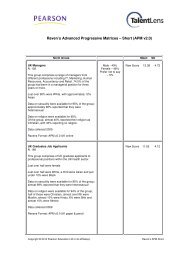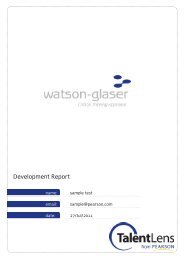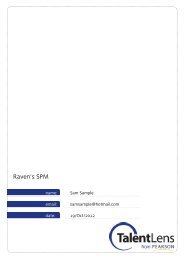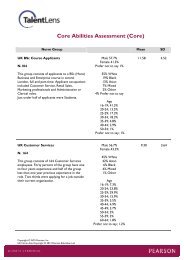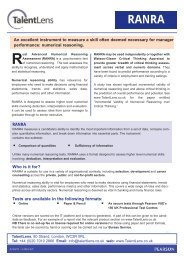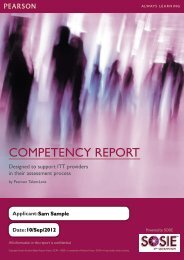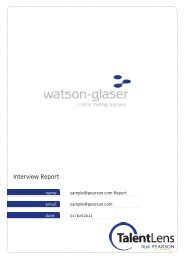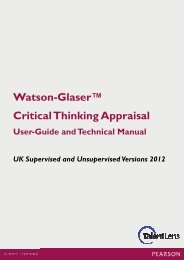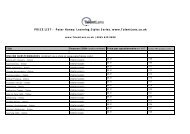Giotto Sample Report - TalentLens
Giotto Sample Report - TalentLens
Giotto Sample Report - TalentLens
- No tags were found...
You also want an ePaper? Increase the reach of your titles
YUMPU automatically turns print PDFs into web optimized ePapers that Google loves.
<strong>Giotto</strong> Narrative Interpretationname:email:date:<strong>Sample</strong> <strong>Report</strong>online@talentlens.co.uk17/May/2011
contents of the reportsection 1: introductionThis section provides information about the <strong>Giotto</strong> test and its report.pg 3section 2: brief characterisationThis section provides a brief over-view of the candidate’s personality traits.pg 3section 3: the seven scalesThis chart summarises the individual’s behaviour based upon seven key scales.pg 4section 4: the giotto narrativeThe narrative provides analysis and discussion based upon the individuals scores.pg 5name<strong>Sample</strong> <strong>Report</strong> page 2(c)Pearson Education Ltd or its affiliate(s). All rights reserved. Adapted by permissionwww.talentlens.co.ukonline@talentlens.co.uk - 17/May/2011 Assessment powered by Getfeedback © 2011
section 1: introduction<strong>Giotto</strong> is based on a model of personality derived from the work of the classical scholar Prudentius. Prudentiusbelieved that the human character develops through a series of choices that we make throughout our lives. These laydown habitual styles of responding that become increasingly ingrained as we mature. <strong>Giotto</strong> interprets these choicesin terms of habitual working styles.Thus we may have developed the habit of (A) being prudent or careless in carrying out our tasks; (B) working hardor only as necessary; (C) being prone to settle disputes by reconciliation or by aggression; (D) being trusting orsuspicious in our dealings with our colleagues; (E) having faith in our employers or only in ourselves; (F) being openor scheming in our dealings with others; and (G) of welcoming or resisting change at work.Although Prudentius saw these choices in terms of virtues and vices, he did not believe in the wholly virtuous person.Rather, he saw it as part of the human condition that we each have our own particular strengths and weaknesses.<strong>Giotto</strong> recognises that each employment setting will require an optimal balance of characteristics among itsemployees. Ideally we should each seek the type of work that will utilise our strengths and accommodate ourweaknesses.<strong>Giotto</strong> is designed to assess our primary strengths and weaknesses to enable us to match these to an appropriatechoice of work. Given below are 7 scores relating to the characteristics outlined above. Each score is on a scale from1 to 19. <strong>Giotto</strong> has been standardised using a representative sample of 700 working people in the UK to give a meanscore of 10 (s.d.= 4).<strong>Giotto</strong> scores should not be interpreted in isolation. Account should be taken of the respondent’s work history, socialand educational background, present employment, future job aspirations and reasons for taking the test. Othersources of information, such as interview or Curriculum Vitae, should also be considered. <strong>Giotto</strong> should only be usedby a qualified professional.section 2: brief characterisationThe box below indicates two key strengths and two key weaknesses of the candidate to give a brief overview of thecandidate’s character.Personality SummaryResourceful and enthusiastic about the future.Slow to anger and calm in the face of adversity.Tends to be suspicious of the intentions of others.Can dislike working under pressure.name<strong>Sample</strong> <strong>Report</strong> page 3(c)Pearson Education Ltd or its affiliate(s). All rights reserved. Adapted by permissionwww.talentlens.co.ukonline@talentlens.co.uk - 17/May/2011 Assessment powered by Getfeedback © 2011
section 3: the seven scalesintroductionPrudence - assesses degree of care that is likely to be taken in carrying out a task. It is of relevance to occupations inwhich mistakes can have particularly severe consequences.Fortitude - assesses work ethic and is of relevance to positions where absenteeism may present a problem, or wherestaff are required to work long hours under duress.Temperance - assesses the ability to control aggression in whatever form. It is of relevance to environments wherebullying has been a particular concern.Justice - assesses fairness in judging the actions of others. It is of relevance to environments which are beset withstrife.Faith - assesses the sense of obedience to company policy and is of relevance to work situations that necessitateindependent action of staff on the organisation's behalf.Charity - principally composed of social desirability items. Low scores indicate lack of openness in responding. Bearthis in mind when interpreting all other scales.Hope - assesses a sense of purpose and forward-looking approach. It is of relevance to organisational settings aboutto undergo major change.chart for seven scales1 2 3 4 5 6 7 8 9 10 11 12 13 14 15 16 17 18 19May be careless indealing withmundane tasksCan dislike workingunder pressureSometimesimpatient of thefoibles of othersTends to besuspicious of theintentions of othersWill want to actwith a degree ofindependenceCan be closed orsecretive in dealingwith othersSomewhatpessimistic aboutthe futurePrudenceFortitudeTemperanceJusticeFaithCharityHopeCareful and sensiblewhen carrying outgiven tasksAn effective andconfident orientationto hard workSlow to anger andcalm in the face ofadversityBalanced andimpartial in decisionmakingShows obedience toauthority and asense of dutyHonest or open indealings with othersResourceful andenthusiastic aboutthe futurename<strong>Sample</strong> <strong>Report</strong> page 4(c)Pearson Education Ltd or its affiliate(s). All rights reserved. Adapted by permissionwww.talentlens.co.ukonline@talentlens.co.uk - 17/May/2011 Assessment powered by Getfeedback © 2011
section 4: the giotto narrativenarrative interpretation• <strong>Sample</strong>'s level of optimism concerning the future appears to be in the high average range. He is usuallypositive about change, and recognises that it is a natural part of today's rapidly moving world. He generallyprefers to look on the bright side of things and has a reasonable level of confidence that things will turn outright. He is normally willing to go along with proposals for trying out new ways of doing things, andmaintains a curiosity about how they will turn out. He is not often shy, and is usually willing to engage in theprocess of planning change. However, he may also think that sometimes the more traditional ways of doingthings might actually have been better, especially where this can be supported by evidence.• <strong>Sample</strong> is less likely than most to become angry, and is able to keep his feelings to himself on most occasions.Nevertheless, he is able to let people know when he thinks they are provoking him. He is usually patient, andit is only when he believes an outrage has been committed that he will feel the need to show hisdisapproval. When he is the target of bullying he is not always able to stand up for himself. Neither is hewilling to put up with such behaviour. He will try to avoid confrontation unless pushed into it, and may berather hesitant about pressing his case, especially if he believes this will lead to unpleasantness.• <strong>Sample</strong> is hesitant about accepting people's motives at face value, and generally has little time for those whothink they can talk him into things against his will. He should be particularly effective in situations thatrequire independent working as he tends to prefer to do things himself rather than take the risks involved indelegating to others. While colleagues may sometimes see him as a little sensitive, this is usually becausethey fail to recognise the difficulties he encounters. People often find it all too easy to blame him for theirown mistakes, and he is not always able to find an adequate avenue of escape when this occurs. Like mostpeople, he wants to receive recognition for his achievements, and he is likely to feel hurt should this not beforthcoming.• <strong>Sample</strong> is not generally the sort of individual who would appear 'gushing' when he first meets people andwould normally think carefully before he accepts them with confidence. He is wary of the dangers of beinghoodwinked, and therefore he is unlikely to make any decisions without fully considering the facts of thematter as he sees them.• <strong>Sample</strong> welcomes a relaxed atmosphere at work. He generally values his role and appreciates the manyopportunities it presents him. However, he probably does not see work as the most important aspect of hislife. His preferred job environment is normally one that compliments his activities outside the workplace anddoes not interfere too much with his social life. He does not like being placed under excessive pressure toperform, particular by his supervisors, but is usually willing to help if asked in the right way. He generallyknows his place, and expects his managers to manage. If this is performed effectively he can be a veryproductive worker.• At times, <strong>Sample</strong> may present himself as being rather unsteady and too laid back, so that colleagues may feelthat he could show more commitment. However, while he may not always be motivated by work-relatedambitions, he is quite usually capable of meeting targets that are clearly set. Indeed, because he may notbelieve that it is necessary for him to strive for promotion, he is likely to be comfortable with his currentposition. Consequently, he may well enhance the social environment in the workplace, particularly wherethere are a number of more competitive colleagues. His normally carefree nature may occasionally meanthat he can be casual or disorganised and not always aware of time. However, he will usually respond wellwhen he feels he is being fully appreciated.name<strong>Sample</strong> <strong>Report</strong> page 5(c)Pearson Education Ltd or its affiliate(s). All rights reserved. Adapted by permissionwww.talentlens.co.ukonline@talentlens.co.uk - 17/May/2011 Assessment powered by Getfeedback © 2011




